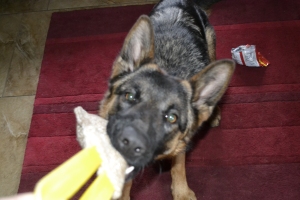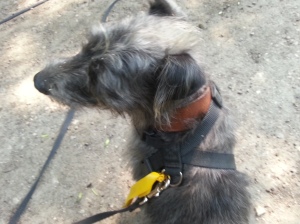The training of any dog can include prey drive, which is in layman’s terms playing with a ball or tug. Something that moves like prey, something that wiggle and moves fast.
This prey harness can be used to teach a dog anything, for obedience dogs it is used as a reward for getting the correct position, it is the same for security dogs tugs or balls are used as a reward for the behaviour we want, such as barking. The only thing that security training is different to any other prey drive training in dogs is the that the dog learns to demand the tug or ball, we harness this to make them desperately want it. This desperation leads to frustration creating a keen dog that will bark at anyone as they think they are withholding the bar or ball from them.
Prey drive taps into the dogs natural instincts to chase and bite anything that moves as it could be a potential food source, in domestic dogs this has turned into biting and chasing anything due to selective breeding of working dogs. This type of chase behaviour is not seen as much is breeds which are pets such as Maltese. But it is very prevalent in the Border Collie and German Shepherd, both dogs originally selected for working with stock and guarding. Most breed have been bred with a inhibited kill section of the normal prey drive, which is Sight-Chase-Catch-Kill, the only breeds that still maintain this kill section are hunting breeds such as Terriers, which are used as vermin control.
Tasha gets her tug and a game when she barks on command. The positive play reinforces the desired behaviour so she is more likely to do it again. This reinforcement will set her up for life, she will soon learn to bark on command as a reward may come in the form of the tug, tapping into her prey drive.
This type of training works well for security dogs as they bond with their handler, as well as avoiding food treating which can cause accidents as well as lead to the dog taking food from strangers, this could be potentially fatal for the dog. Prey drive could also be used for any pet dog, as well as accompanied by treat reward and verbal praise in the home.
It might seem that this type of training is only for larger breeds or security training for patrol dogs, but it the same training for any dog. This includes the training of drugs dogs, who primarily use tennis balls for a reward and to start their initial training. Spaniels especially have a high prey drive which is why they are used as gun dogs, their prey drive doesn’t go as far as killing as that has been bred out of them, it instead creates an instinct to chase and grab anything that moves, then bring it back to its owner. This is tapped in for drugs dogs as they want to chase the ball, and that behaviour in itself becomes the reward.
Remember to play with your dog, prey drive is usually untouched by pet dog trainers as with the right timing can be used to very quickly reinforce any behaviour. The dog isn’t working for a bribe it is wanting to work to get its reward, a reward that is suited to its personality be it a ball or a bite bar, or anything the dog will play with.
(Tip – Don’t use a tennis ball for larger breeds as they can cause accidents, instead use a rubber ball on a rope, it is good for pulling and the dog is less likely to accidentally swallow it or chew it up)




